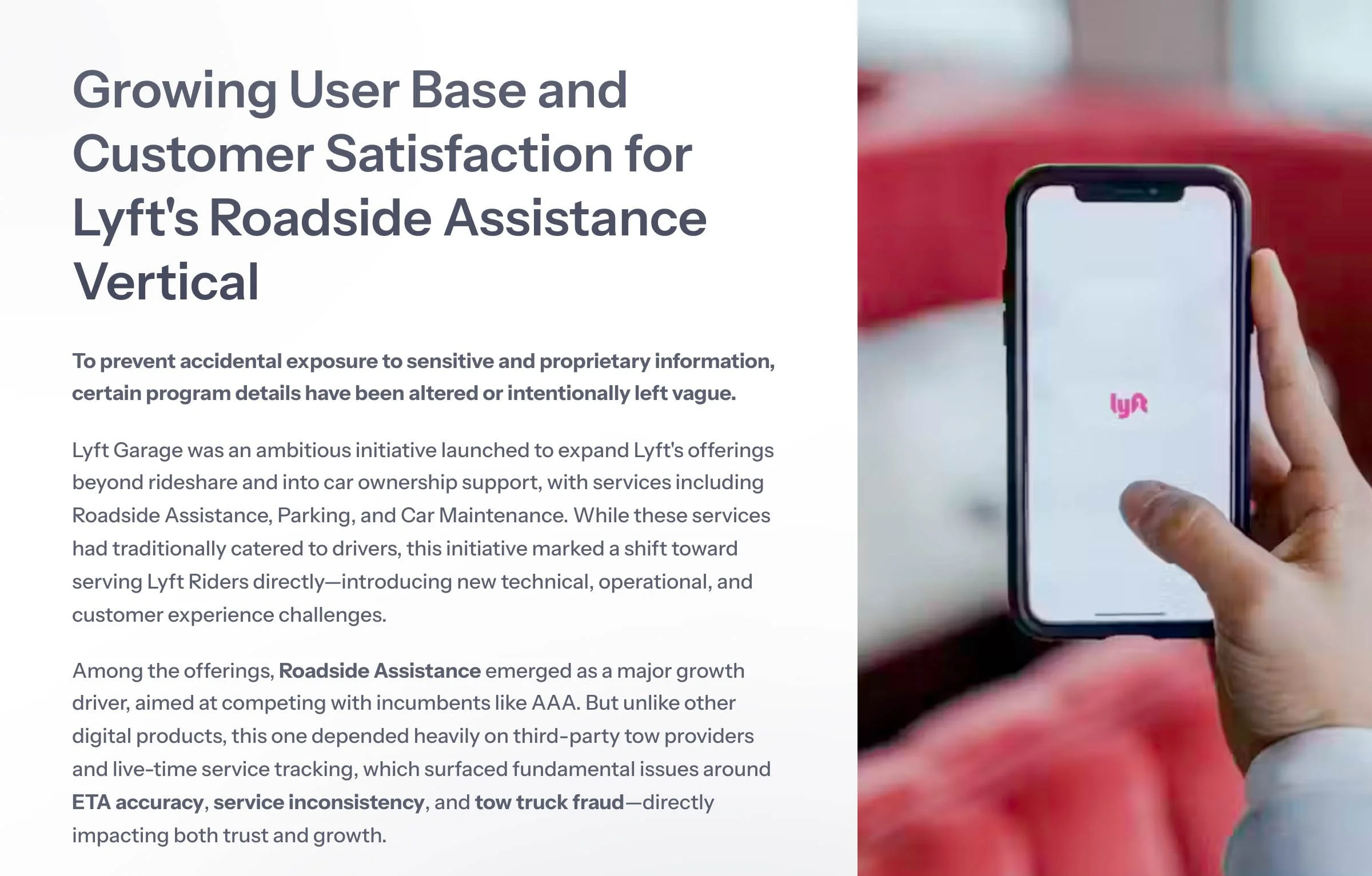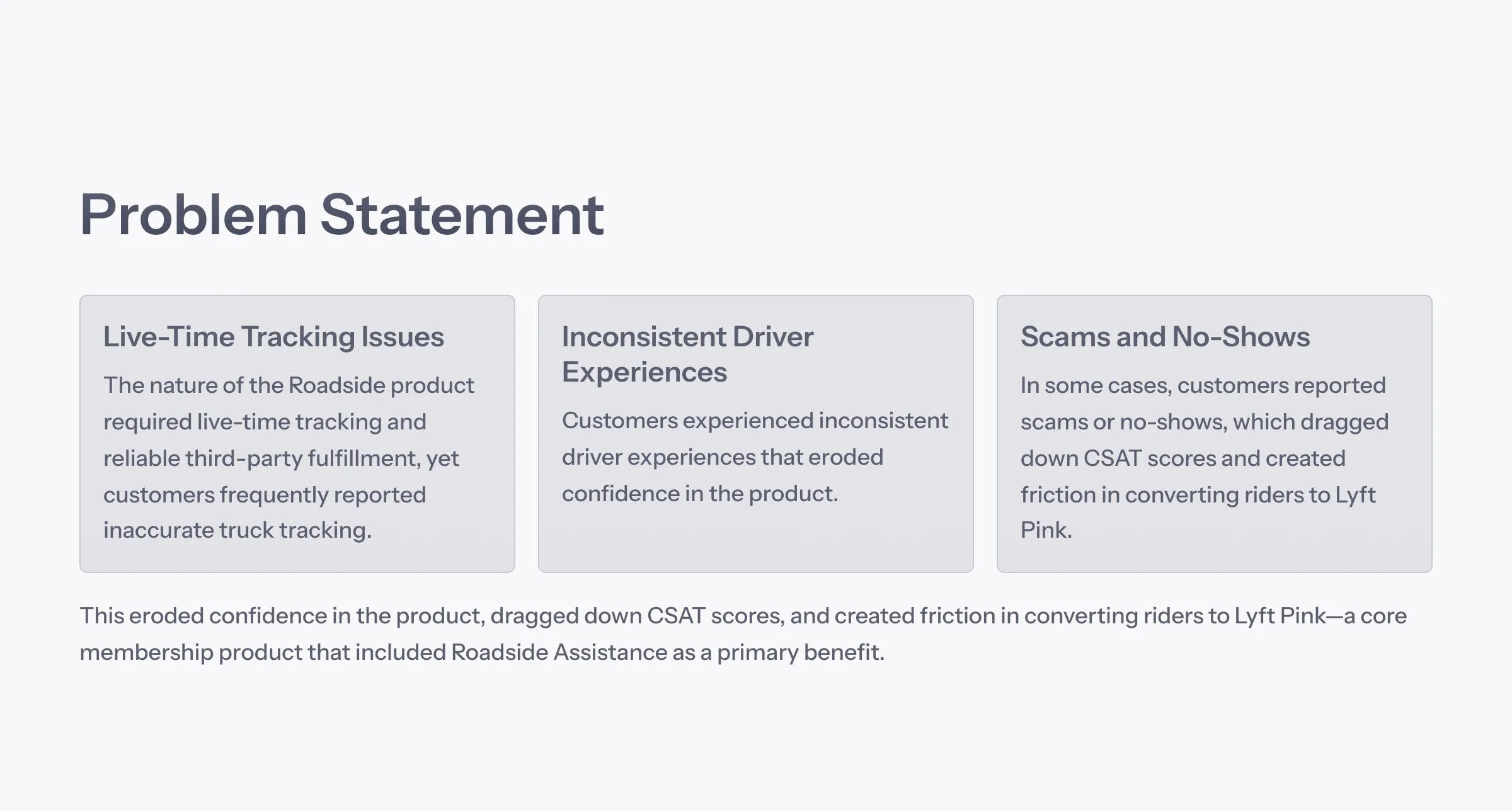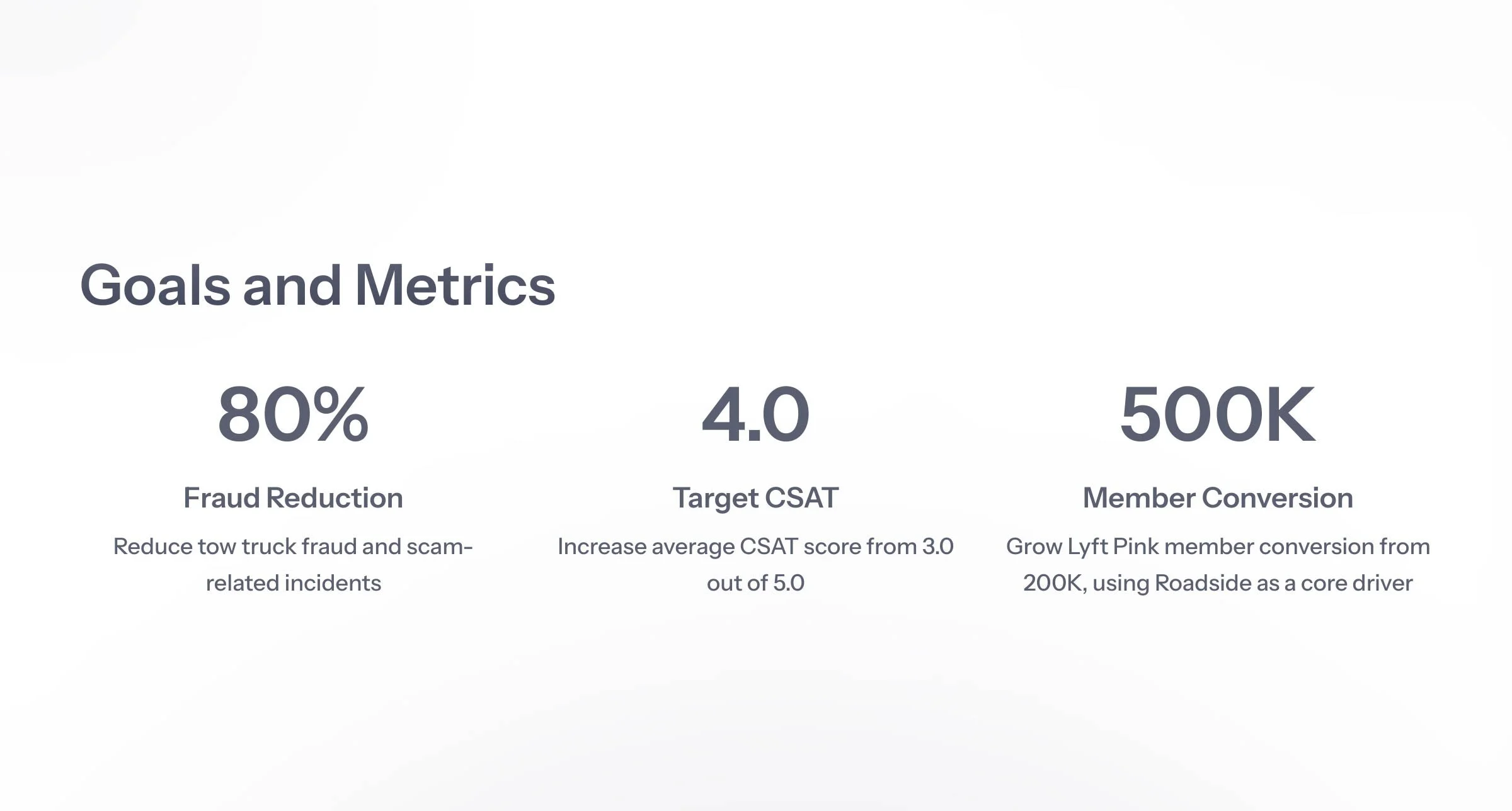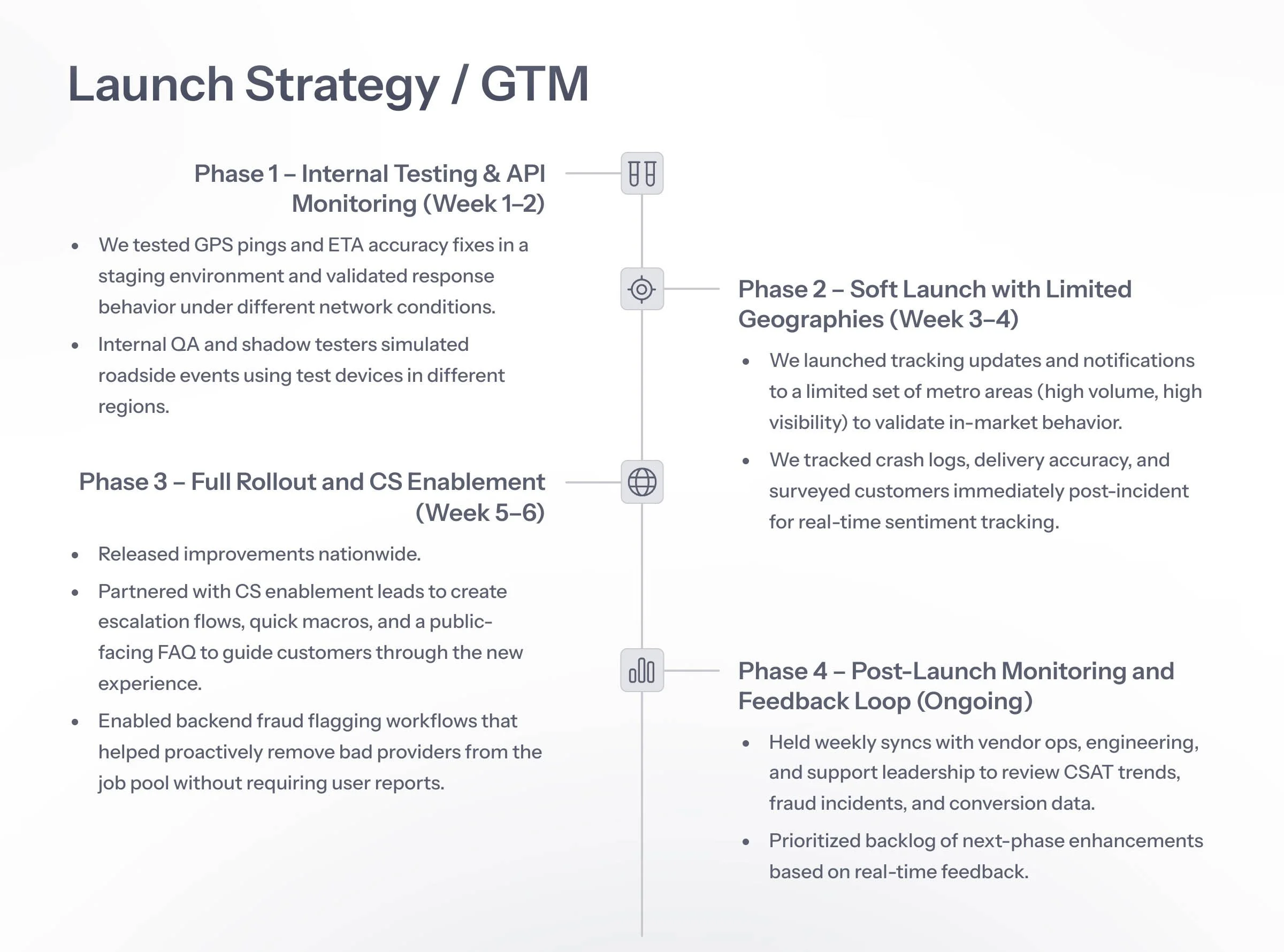During my time at Lyft, I was part of the Lyft Garage product team - Lyft’s big bet on redefining car ownership by offering car maintenance, parking, and roadside assistance to users. My key focus was defining improvements to the roadside assistance MVP and increasing customer satisfaction to drive up conversion of Lyft Pink members.
Skills Showcased:
Problem discovery and root cause analysis
Cross-functional collaboration with engineering, CX, and vendor teams
Customer-centric UX and communication improvements
Data-informed prioritization and roadmap planning
Go-to-market execution with phased rollout strategy
Operational risk mitigation and trust management
KPI definition and success tracking
Vendor performance management and quality control
PRD
Summary
As part of a larger initiative to expand beyond rideshare, we launched Lyft Garage, a product suite focused on car ownership services for riders—including Roadside Assistance, Parking, and Car Maintenance. Roadside Assistance emerged as the key growth driver, offering Lyft Pink members coverage that rivaled incumbents like AAA. However, the product’s dependence on third-party tow partners introduced major fulfillment challenges—ranging from inaccurate live-tracking data to service inconsistencies and fraud. These issues directly impacted trust, customer satisfaction, and conversion to Lyft Pink. To address this, we will focus on improving ETA accuracy, service reliability, and communication—resulting in a smoother customer experience and a more credible value prop for membership growth.
Goals
Decrease fraudulent or scam-related roadside incidents by 80%
Raise average CSAT score from 3.0 → 4.0
Increase Lyft Pink conversions from 200K → 500K, with Roadside as a core driver
Reduce inbound customer support volume related to ETA discrepancies by 30%
Project Scope
This work will span product, engineering, customer experience, and third-party operations. It will involve improving the accuracy of vehicle tracking in the Lyft app, tightening SLAs and data fidelity from our roadside partners, and improving how users are updated throughout the service experience. MVP will focus on location sync, fraud flagging, and push notification enhancements. Scope will exclude major changes to partner onboarding systems or full-scale replatforming of the underlying tracking system.
Requirements
P0 – Must-Haves (Launch Blocking):
We will update app logic to improve the accuracy of tow vehicle GPS tracking, ensuring regular refreshes and fallback logic when GPS data is stale
We will integrate more reliable ETA estimations from our third-party roadside partner, with guardrails for timeout or no-movement detection
We will introduce push notifications and in-app banners that proactively update users on delays, ETAs, or reroutes
We will build a provider risk scoring model using CSAT data, fraud reports, and completion rates—automatically flagging and deprioritizing low-trust partners
All updates must meet SLAs for incident communication timing and app reliability metrics
P1 – High Impact Features (Enhance Utility):
We will implement a backend trigger that automatically removes underperforming providers after X flagged incidents or poor customer scores
We will introduce a “live-truck view” map feature showing step-by-step ETA countdowns with real-time refreshes
CS and ops teams will have access to a dashboard that surfaces provider performance and user complaints in near real time
We will provide a set of macros and agent training to ensure consistent support escalation paths and response quality
Public-facing FAQ and trust messaging will be updated to clearly communicate what users can expect from the service
P2 – Future Enhancements (Post-MVP Quality-of-Life):
A real-time service reliability score will be shown in-app per region based on recent fulfillment metrics
A CSAT micro-survey will be embedded post-service to capture insights immediately after resolution
We will consider surfacing provider profiles with reviews for added transparency and trust
Integrations with membership acquisition flows will dynamically showcase positive CSAT trends in Roadside to boost Pink conversion rates
Launch Plan / GTM
Given the operational risk of delivering a poor user experience during emergencies, we will roll out in controlled phases:
Week 1–2: Internal Testing & Provider QA
QA GPS and ETA fixes in staging environments under different bandwidth and phone conditions
Sync with third-party partners to validate that API logic, vehicle updates, and completion statuses are being reliably passed
Week 3–4: Pilot Launch in Select Markets
Release tracking and notification updates in 2–3 high-volume markets (e.g. LA, NYC, Austin)
Monitor CSAT feedback and GPS movement patterns in live jobs; collect and categorize early issue reports
Week 5–6: Full Rollout and CS Enablement
Launch updates nationwide, paired with CS onboarding docs, macros, and escalation flows
Begin proactive flagging/removal of low-performing providers based on updated rules
Launch marketing refresh to clarify expectations and build user trust in Lyft Pink roadside coverage
Ongoing: Feedback Loop and Optimization
Weekly syncs with CS, Product, and Ops to triage flagged cases
Plan Phase 2 features based on uptake, NPS, and fraud trends
Refresh internal dashboard weekly with key KPIs to identify new hotspots or regional risk clusters
Success Criteria
CSAT increases from 3.0 → 3.8+ within first 5 weeks of rollout
Tow fraud/scam reports decrease by 80%+ as flagged providers are removed
Support tickets referencing “truck not moving” or “no ETA” drop by 30%
Roadside-related Lyft Pink conversions increase by 8–10%, based on post-service surveys and onboarding attribution
Measurement Plan
Track live job data to compare ping frequency and ETA variance before and after rollout
Monitor CSAT and fraud report volume segmented by region and provider
Measure conversion lift for Lyft Pink in relation to positive post-roadside experiences
Audit support macros and customer escalations for consistency and sentiment
Risks
If GPS fixes are only partially effective, user trust may further erode due to over-promising
Misaligned SLAs or missing provider data could cause confusion or increased escalations
Over-removal of providers without regional backup may lead to unfulfilled jobs in smaller markets
If the communication strategy isn’t clear, users may still default to contacting support—even if the tracking is improved






